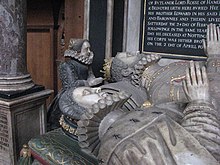St Mary the Virgin's Church, Bottesford
| St Mary the Virgin's Church, Bottesford | |
|---|---|
 St Mary the Virgin's Church, Bottesford, from the southeast | |
| 52°56′37″N 0°48′00″W / 52.9435°N 0.8001°W | |
| OS grid reference | SK 807 391 |
| Location | Bottesford, Leicestershire |
| Country | England |
| Denomination | Anglican |
| Website | St Mary, Bottesford |
| History | |
| Status | Parish church |
| Dedication | Saint Mary the Virgin |
| Architecture | |
| Functional status | Active |
| Heritage designation | Grade I |
| Designated | 1 January 1968 |
| Architect(s) | Sharpe and Paley (1847–48 restoration) |
| Architectural type | Church |
| Style | Gothic |
| Administration | |
| Diocese | Leicester |
| Archdeaconry | Leicester |
| Deanery | Framland |
| Parish | Bottesford |
| Clergy | |
| Vicar(s) | Revd F. P. R. J. Connell |
St Mary the Virgin's Church is in the village of Bottesford, Leicestershire, England. It is an active Anglican parish church in the deanery of Framland, the archdeaconry of Leicester and the diocese of Leicester. Its benefice is united with those of eight local parishes.[1] The church is recorded in the National Heritage List for England as a designated Grade I listed building.[2]

Sometimes known as the "Lady of the Vale", it is a large church which has the 2nd highest spire in Leicestershire (at 212 feet). The oldest part of the church dates from the 12th century, with additions and alterations made during the following three centuries,[3] including the nave and spire in the 15th century. The chancel was rebuilt in the 17th century to accommodate the monuments of the Manners family, earls (later dukes) of Rutland, which completely fill it.[4] The monuments include work by Caius Gabriel Cibber and Gerard Johnson the elder. One of the Rutland tombs is famous for its inscription, which attributes a death to witchcraft by the Witches of Belvoir.
A number of restorations were carried out during the 19th century.[2] The restoration in 1847–48 was carried out by the Lancaster partnership of Sharpe and Paley. This involved restoring the nave, aisles, and transepts, replacing the seating and the roofs of the aisles, removing the gallery, inserting the tower screen, adding new pinnacles, reflooring the church and replacing windows. This cost £2,235 (equivalent to £280,000 in 2023),[5] towards which the Duke of Rutland gave £600, the Revd F. J. Norman gave £550, and a grant of £110 was received from the Incorporated Church Building Society.[6]
The churchyard contains war graves of fifteen Commonwealth service (mainly Royal Air Force) personnel, five from the First World War and ten from the Second World War.[7]
Burials
- Thomas Manners, 1st Earl of Rutland
- Eleanor Paston, Countess of Rutland
- Henry Manners, 2nd Earl of Rutland and his wife Margaret Neville (d. 13 October 1559)
- Edward Manners, 3rd Earl of Rutland and his wife Isabel Holcroft
- John Manners, 4th Earl of Rutland and his wife Elizabeth Charlton, daughter of Francis Charlton of Apley Castle
- Roger Manners, 5th Earl of Rutland and his wife Elizabeth Sidney, daughter of Sir Philip Sidney
- Francis Manners, 6th Earl of Rutland
- George Manners, 7th Earl of Rutland
- John Manners, 8th Earl of Rutland and his wife Lady Frances Montagu Manners
- Elizabeth Manners, Duchess of Rutland in the family vault
See also
References
- ^ Bottesford: St Mary the Virgin, Bottesford, Church of England, retrieved 10 August 2011
- ^ a b Historic England, "Church of St Mary, Bottesford (1075095)", National Heritage List for England, retrieved 30 May 2012
{{cite web}}: CS1 maint: postscript (link) - ^ Hughes, John M. (2010), Edmund Sharpe: Man of Lancaster, John M. Hughes, p. 218
- ^ Betjeman, John, ed. (1968) Collins Pocket Guide to English Parish Churches; the North. London: Collins; p. 166
- ^ UK Retail Price Index inflation figures are based on data from Clark, Gregory (2017). "The Annual RPI and Average Earnings for Britain, 1209 to Present (New Series)". MeasuringWorth. Retrieved 7 May 2024.
- ^ Brandwood, Geoff; Austin, Tim; Hughes, John; Price, James (2012), The Architecture of Sharpe, Paley and Austin, Swindon: English Heritage, p. 214, ISBN 978-1-84802-049-8
- ^ BOTTESFORD (ST. MARY) CHURCHYARD, Commonwealth War Graves Commission, retrieved 4 March 2013

